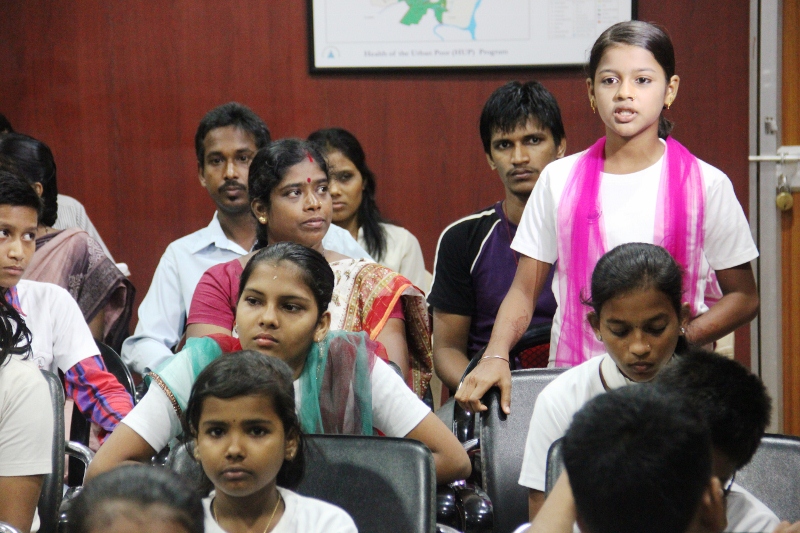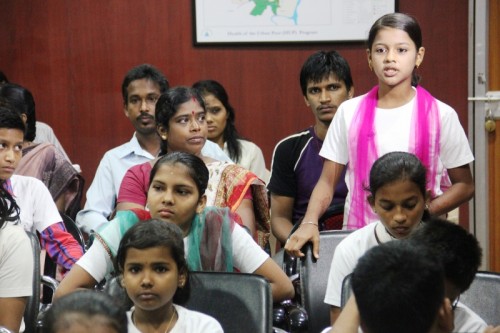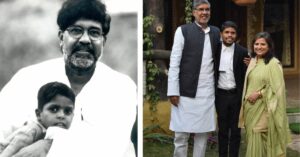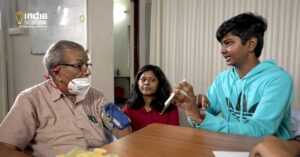They Can’t Vote. But They Still Know What They Want From These Elections. This Is The Children’s Manifesto!
At an age when most children are interested in their toys and gadgets, these kids from slums in Bhubaneshwar are dealing with real life problems and have clear thoughts on what they want from their elected leaders. What's more, they have also drawn up a manifesto for their demands! Find out what they want and what the politicians think.

At an age when most children are interested in their toys and gadgets, these kids from slums in Bhubaneshwar are dealing with real life problems and have clear thoughts on what they want from their elected leaders. What’s more, they have also drawn up a manifesto for their demands! Find out what they want and what the politicians think.
Bikash, 10, the son of daily wage labourers, lives in a slum in Bhubaneswar, the state capital of Odisha. On most days, this Class Five student of Ruchika School in the neighbourhood has to skip studies and work with his parents and two elder sisters on construction sites to supplement the family income. Although Bikash is not yet a voter, he wants political leaders hoping to come to power after General Election 2014 to promise they will tackle the issue of child labour.
Similarly, Jasmin, 12, a Class Eight student, wants her elected representative to provide safe drinking water near her Science Park ‘basti’ so that she doesn’t have to stand in line for hours at a tap a long distance away from her home and end up being late for her classes. The three tube wells in the slum she lives in have been dysfunctional for some years now and although there is piped water in homes here, erratic supply has the 500 residents making a beeline to a faraway source nearly every day. Apart from water, young Jasmin is demanding toilets in their homes so that she doesn’t have to step out at the crack of dawn for her daily ablutions.
Says Bikash, “Although I am not eligible to vote, I am a beneficiary of all development schemes and I should be given priority. Don’t I deserve amenities and a chance for a better life?” Adds Jasmin,
Safe drinking water is a basic facility that the government is supposed to provide to the people, so why has my slum been deprived of it? Leaders have to address these matters because it has adverse effects on our lives.
Like Bikash and Jasmin, across the city (Bhubaneshwar) there are around 100 child leaders who have put their thoughts together to create a Children’s Manifesto and Charter of Demands for political parties. They are no longer okay about their needs being overlooked and it is the Hamara Bachpan campaign that has enabled them to reflect on the larger social problems that affect them and look for workable solutions.
According to ‘Slums in India – A Statistical Compendium 2011’, published by the Government of India, every eighth urban child in the country in the age-group of 0-6 years stays in slums. Moreover, a report compiled by the National Buildings Organisation (NBO) of the Ministry of Housing and Urban Poverty Alleviation, reveals that children living in slums constitute 13.1 per cent of the total child population in urban areas.
Urban poverty impacts these youngsters severely. As per a Planning Commission report, 50 per cent of urban child mortality in slums is the result of the lack of clean drinking water, while 23 million are at risk due to poor sanitation. According to the World Health Organization (WHO), 22 per cent of children die because of respiratory diseases every year. And while there should be provision for “well ventilated houses for better indoor air quality and development of eco-friendly neighborhood”, in reality, the Census 2011 reveals, only 1 per cent notified and 7 per cent non notified slums in India have an electricity connection.
In this bleak scenario, the Hamara Bachpan campaign has emerged as an important initiative to create awareness and protect the rights of children living in slums. It is a national programme that works on ensuring a safe and healthy environment for impoverished city kids and calls for inclusion of child-friendly components in government schemes such as the Jawaharlal Nehru National Urban Renewal Mission (JnNURM) and Rajiv Awas Yojana (RAY). At present, it is active in 15 states and has reached out to 15,000 children through its child clubs.
“Despite being a signatory to the United Nation’s Convention on Child Rights, India has not been very successful in safeguarding their rights. Whether it is about education, nutrition and health or safety, children here have not been given a fair deal,” observes Ananta Prasad, Communications Officer, Hamara Bachpan campaign.
Creating awareness that facilitates advocacy to bring about change is the main focus of this campaign. Adds Prasad,
Initially, the community did question our existence but through street plays and meetings with parents we managed to convince them that we were interested in bringing about change at the policy level that would enable them to have better living conditions, increased opportunities and so on.
Empowering children with knowledge and giving them a voice has produced encouraging results. Sasmita Mohanty, 10, a Class Three student from Salia Sahi slum of Bhubaneswar, is a child club leader who has made a significant contribution in her locality. After the tragic death of a seven-year-old girl, who was raped and murdered few months ago, a very disturbed Sasmita gathered her friends and went to meet the Commissioner of Police, R.K. Sharma, the very next day, demanding more street lights and a dedicated police outpost in their area. Not only did Commissioner Sharma listen to the children – incidentally, they were not accompanied by any adults, including their parents – but this interaction led to increased police patrolling. Further, working street lights have been installed in the neighbourhood as well.

Besides safety, Sasmita has raised the issue of access to education and a curb on child labour. What has given her efforts – and that of other child leaders – a definite boost are the upcoming elections. As the activists of Hamara Bachpan campaign motivated them to create a Children’s Manifesto, the club kids responded wholeheartedly. Remarks Preeti Prada, National Campaign Coordinator, Humara Bachpan,
No political party has directly spoken of or considered the issues related to children, who comprise 40 per cent of the population. We have tried to empower them to become the watchdogs of urban development policies. As citizens, their well being should also be on the agenda of political parties.
So what is this Children’s Manifesto all about? “We want all political parties to support and create provisions to make Odisha a child-friendly state, by including the following demands in their political manifestoes,” reads the document. What are these demands? The charter calls for ensuring urban development schemes like RAY and JnNURM are revised in the best interest of children, that there is adequate access to clean drinking water, sanitation facilities, a pollution-free living environment, proper electricity supply, well-ventilated housing and adequate recreational spaces. Other demands include participation of children at every phase of the planning process for better living conditions, an increase in government allocation for children’s well being and, most importantly, a zero tolerance policy towards child labour.
Of course, when the Hamara Bachpan child leaders presented the Children’s Manifesto to the local politicians at a recent meeting, as intended, it had a serious impact. When Sajjan Sharma, a local Bharatiya Janata Party (BJP) leader, read through the document he relialised that this was no ordinary initiative. According to him, “The voices raised from this forum are those that we have as yet been neglecting. We have deprived them of their rights and it is high time that this situation changes.” Representatives from other political parties including Pratap Jena of Congress, Nishikant Mohapatra of Aam Admi Party (AAP), Hemant Rath of Kalinga Sena and Suresh Panigrahy of Communist Party of India (Marxist) have had similar reactions. Says Nishikant Mohapatra,
I do admit that the children have raised the right points. They are our future and we can’t afford to overlook them. By raising their voice they have raised our hopes for a better tomorrow. There is positive change waiting to happen and these alert children are going to make it happen.
This story made me
- 97
- 121
- 89
- 167
Tell Us More
We bring stories straight from the heart of India, to inspire millions and create a wave of impact. Our positive movement is growing bigger everyday, and we would love for you to join it.
Please contribute whatever you can, every little penny helps our team in bringing you more stories that support dreams and spread hope.



















